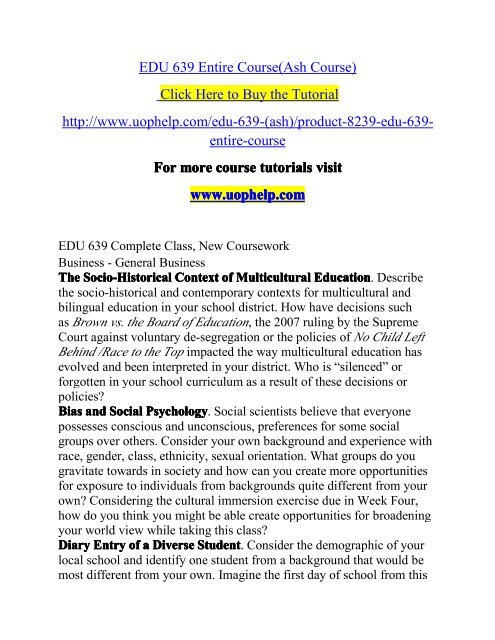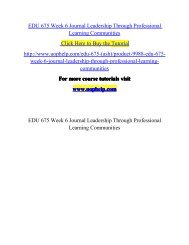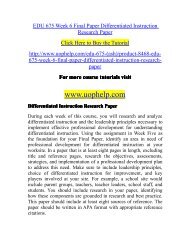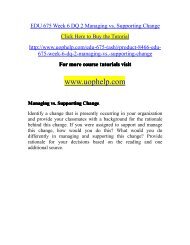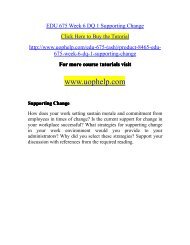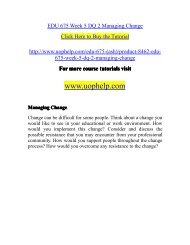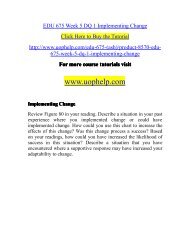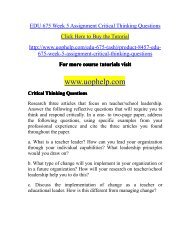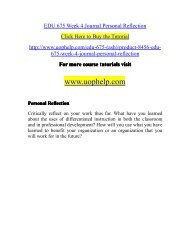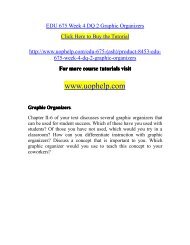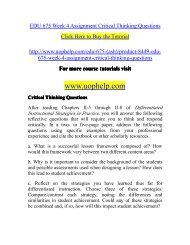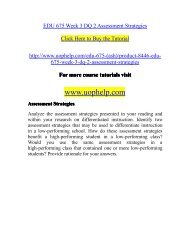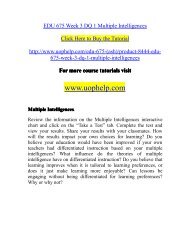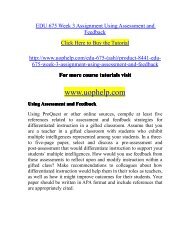EDU 639 Entire Course(Ash Course)/UOPHELP
For more course tutorials visit www.uophelp.com EDU 639 Complete Class, New Coursework Business - General Business The Socio-Historical Context of Multicultural Education. Describe the socio-historical and contemporary contexts for multicultural and bilingual education in your school district. How have decisions such as Brown vs. the Board of Education, the 2007 ruling by the Supreme Court against voluntary de-segregation or the policies of No Child Left Behind /Race to the Top impacted the way multicultural education has evolved and been interpreted in your district. Who is “silenced” or forgotten in your school curriculum as a result of these
For more course tutorials visit
www.uophelp.com
EDU 639 Complete Class, New Coursework
Business - General Business
The Socio-Historical Context of Multicultural Education. Describe the socio-historical and contemporary contexts for multicultural and bilingual education in your school district. How have decisions such as Brown vs. the Board of Education, the 2007 ruling by the Supreme Court against voluntary de-segregation or the policies of No Child Left Behind /Race to the Top impacted the way multicultural education has evolved and been interpreted in your district. Who is “silenced” or forgotten in your school curriculum as a result of these
Create successful ePaper yourself
Turn your PDF publications into a flip-book with our unique Google optimized e-Paper software.
<strong>EDU</strong> <strong>639</strong> <strong>Entire</strong> <strong>Course</strong>(<strong>Ash</strong> <strong>Course</strong>)Click Here to Buy the Tutorialhttp://www.uophelp.com/edu-<strong>639</strong>-(ash)/product-8239-edu-<strong>639</strong>-entire-courseFor more course tutorials visitwww.uophelp.com<strong>EDU</strong> <strong>639</strong> Complete Class, New <strong>Course</strong>workBusiness - General BusinessThe Socio-Historical Context of Multicultural Education. Describethe socio-historical and contemporary contexts for multicultural andbilingual education in your school district. How have decisions suchas Brown vs. the Board of Education, the 2007 ruling by the SupremeCourt against voluntary de-segregation or the policies of No Child LeftBehind /Race to the Top impacted the way multicultural education hasevolved and been interpreted in your district. Who is “silenced” orforgotten in your school curriculum as a result of these decisions orpolicies?Bias and Social Psychology. Social scientists believe that everyonepossesses conscious and unconscious, preferences for some socialgroups over others. Consider your own background and experience withrace, gender, class, ethnicity, sexual orientation. What groups do yougravitate towards in society and how can you create more opportunitiesfor exposure to individuals from backgrounds quite different from yourown? Considering the cultural immersion exercise due in Week Four,how do you think you might be able create opportunities for broadeningyour world view while taking this class?Diary Entry of a Diverse Student. Consider the demographic of yourlocal school and identify one student from a background that would bemost different from your own. Imagine the first day of school from this
student’s perspective as you are introduced to the class as his or her newteacher. This is a creative writing piece where you are expected to stepoutside your own world view and into the shoes of the “other” in yourclassroom. You may need to research a bit about the culture of thestudent whose perspective you will be writing from and ask friends orcolleagues to help you better understand your typical body language andhow that does or might translate to the classroom and teaching style. Usethe following guiding questions to help guide you in writing this 1-2page paper:a. What do you think the student’s first impressions of you might be?(Be honest and consider how the verbal and non-verbal cues you mightgive out would be interpreted by this student).b. How might the student relate to your background? (i.e. Do you appearto represent the dominant group in society and would your relationshipwith the dominant group impact your relationship with the student?)c. How do you address and interact with the student and what are someof the ways you strive to engage all students in the classroom?Gender and Gender-Fluidity. View the short documentaryentitled, I’m Just Anneke. How does gender color one’s perspective onthe world and relation to society? How are gender and genderstereotypesperpetuated by schools? What do you think about genderfluidityand how do you imagine Anneke would fair in your local school?Do you agree with the way Anneke’s endocrinologist and parents areallowing Anneke to experiment with her gender-fluidity?Race: Illusion vs. Reality. Explore the interactive tutorial “SortingPeople: Can You Tell Somebody’s Race by Looking at Them?”. Whatsurprised you about activity? If race is an illusion, why is it so dangerousto be "color-blind" as an educator? How can we work to combatinstitutional racism in our schools and society?Gendered Experiences of Racism. Choose one of the following topicsand respond in a one-to-two page paper:a. Watch the documentary A Girl Like Me, then provide a one-to-twopage commentary on the intersection of race and gender by addressingthe following:
§ How is racism translated to concept of beauty and self-image foryoung, African American women?§ What unique challenges do African American females have comparedto those who are white?§ What about as compared to African American males?§ How might this be different again for young, Latinas and femaleimmigrants from Africa?b. Watch the documentary I am Sean Bell, then provide a one-to-twopage commentary on the intersection of race and gender by addressingthe following:§ What are the unique challenges of being African American and malein the US?§ How is this different from that of females?§ What about as compared to young, African American males?§ How might this be different to or similar to young, Latino males andimmigrants from Africa?You must include at least two resources to support your ideas. Yourpaper must include title and reference pages, and must be formattedaccording to APA guidelines. Length requirement is exclusive of titleand reference pages. For more information on APA formatting, visit the<strong>Ash</strong>ford Writing Center.Segregation. What different forms can segregation take in US schools?When can these methods affirm diversity and when are they detrimentalto learning? Consider economic segregation, culturally-based schools(i.e. African American, Latino, or Native American), gender-specific, orcharter schools. Provide examples from your own experience and at leastone reference in addition to the course textbookAdditive vs. Subtractive Bilingualism. View the videoentitled, Immersion. How accurate (or over-dramatized) is Moises’sstory? What might his teacher and principal have done differently inorder to capitalize on the strengths of what Moisesdoesknow in order tohelp him “add” English to his knowledge base and succeed in USschools? What is working in terms of ELL education in your school?What is not, and why? Would you consider your school’s approach to beadditive or subtractive?
Respond to at least two of your classmates’ postings in a thoughtful andsubstantive manner.Common Beliefs. Explore Commonly Held Beliefs that InfluenceTeachers’ Work with Diverse Students. Before clicking the link, selectone of the commonly held beliefs listed under “Step 2” that you identifywith the most. Explain why you identify with this belief. Next, click thelink and read the information provided. Has your belief changed? Whyor why not?Respond to at least two of your classmates’ postings in a thoughtful andsubstantive manner.The “Cultureof Poverty”. Theorists warn against the continued use ofdeficit theories to connect low social-economic standing to failure inschool. They have left a lasting mark on schools. Identify a student froma low socio-economic status, either from experience or from the coursetext, who is not succeeding. How much of that failure is due to forcesbeyond his or her control and a mismatch between what is being learnedat home and what is valued in the classroom? What other contributingfactors could be present? How can we effectively teach children despitethese contributing factors?Respond to at least two of your classmates’ postings in a thoughtful andsubstantive mannerCultural Immersion and Socio-Historical Research Presentation.Identify a culture you might encounter as a teacher which you have verylittle knowledge about and would like to further explore (you may selectthe same cultural group you chose for the Cultural Immersion Activity inWeeks One, Two, and Three). In a 10-15 slide PowerPoint presentation,you will address the following:a. You will need to design and carry out one experiential activity as partof your report. You may use “A Study of Cambodia and the Cambodian-American Experience” from your text for inspiration, but your researchwill not need to be nearly as in-depth (unless you decide to continueyour research, as the teachers did here, beyond this class). This sectionof your PowerPoint presentation must include the following information:§ An explanation of your experiential activity including:§ What you did
§ Some of the preconceived notions you had going into the activity§ What you learned§ Forms of intercultural communication you might need to use withmembers of this group§ Some ways you hope to continue learning about this group beyond thecourseExamples of cultural immersion activities include, but are not limited to:a. Visit a Middle-Eastern, Asian, Indian or Mexican Market and preparea meal using the ingredients you findb. Watch and critique a Bollywood film, viewing it (as much as ispossible) from a non-western perspectivec. Change your news source to a Middle Eastern network like Al Jazeerafor a weekd. Visit a cultural center, interfaith dialogue or spend an afternoon withsomeone of another culture/religion/ethnicity to learn more about thatworld viewb. Familiarize yourself with and listen to the latest Latino, Hip Hop popmusicfrom the culture you are studyingc. Attend a Pow Wow or dance performance from members of thatcultural groupd. Attend a meeting of the Gay-Straight Alliancee. Visit the areas where the children you are researching live (providedthey are safe)f. Download a demo of “JAWS,” a screen-reader for the blind, and trysurfing the net blindfoldedIn addition to the experiential part of this assignment, you are to researchthe socio-cultural history of the group you are studying. Summarize thehistory and explain their current reality/challenges in the US. Apply thisinformation to what you learned from your experience. Include waysyou can be more sensitive to this background in your curriculum andclassroom. You must include at least 2-3 resources to support your ideas.All in-text citations and reference page must be formatted according toAPA guidelines.Along with the PowerPoint presentation, you must submit a Worddocument title page within the drop box in the online course.
Non-Heterosexual Parents and Kids. View the shortdocumentary Homecoming. Is there anything teachers can do to helpstudents like Ron feel safer in school in towns like Ron’s hometown? Isit better for gay, lesbian, asexual, transsexual or parents with theseorientations to simply seek out more “liberal” schools for their children?Does your school district resemble Lakeville or his new arts high schoolin Minneapolis? How can teachers help such students feel valued andsafe in the classroom where the school culture is not there to supportthem?Respond to at least two of your classmates’ postings in a thoughtful andsubstantive mannerTracking, Grouping and “Dis-AbilityDis-Ability” in the Classroom. Read thearticle, “Into the Mainstream.” What are the unique challenges andrewards of integrating kids labeled “disabled” into mainstreamclassrooms? How can these observations be applied to ideas regardingtracking of non-disabled students and grouping by ability in theclassroom? Provide an example from your own experience or suggestways you could work with students with a wide range of abilities to feelmore integrated in the classroom setting.Respond to at least two of your classmates’ postings in a thoughtful andsubstantive manner.Affirming Diversity within the Community. Identify factors that canhelp you build successful bridges between the educational setting andthe community. Describe how these may impact the community andschool setting. What are the community resources and social services inyour area which encourage parent and community involvement in theschool?Becoming a Multicultural Educator. How do you intend to expandyour horizons to become a multicultural person who helps students addnew cultural ideas to their experience? How can you help students learnmore about their own culture and incorporate what they already knowinto their learning? Respond to at least two of your classmates’ postingsin a thoughtful and substantive mannerWriting the Final Paper
The Final Paper will require you to describe your communitydemographics and predict the type of diversity you might expect to findin your classroom. You will then identify at least three (3) cases whichrepresent some of the different groups found in your community. Ifyou truly live in a mono-cultural area then, simply choose three (3)backgrounds you would like to better understand. You can use realexamples of individuals you know, examples from the textbook or classlinks, or by scouring the internet. The purpose of identifying realstudents is to help you keep in mind the individualized identities ofstudents from these groups and avoid reducing groups to stereotypes.Most likely, you will need to imagine those examples at an ageappropriate to the students you teach or plan to teach.Next, research and identify the community resources and social servicesavailable to you. What institutional barriers do you anticipate you mightneed to contend with in order to provide the best possible learningopportunity for the students in your community? Create a plan of actionwhich will help you cope with these potential barriers and ensure thatfamilies and communities feel that you care about their success.Research and identify forms of intercultural communication you willlikely need to become proficient in and sensitive to in order to help yourstudents feel valued. Then, design techniques and strategies which willenable you to apply these human relationships skills in the educationalsetting and in your interactions with families from diverse communities.What do you anticipate will determine the success or failure of yourschool system in their effort to address students from these groups?


